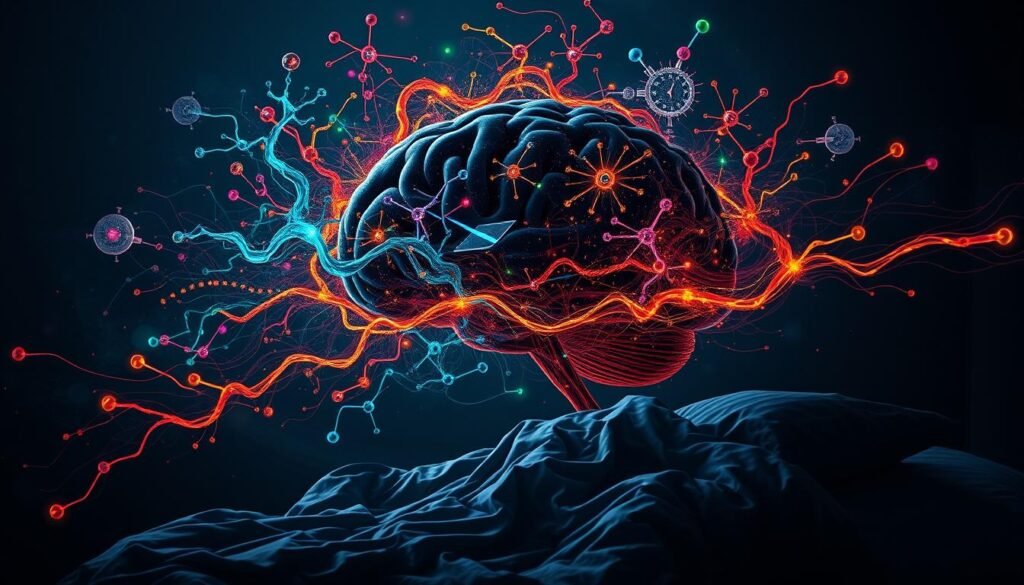Did you know 5% to 15% of people have an insomnia disorder? Chronic issues affect up to 75% of these individuals. This common sleep problem makes daily life hard, hurting productivity and well-being. Understanding the pathophysiology of insomnia is vital. We need to know the complex causes of this condition. Studies on insomnia have shown it’s caused by many things. This includes genes, brain functions, and behaviors.
Insomnia means you’re not happy with your sleep, often feeling tired. This happens even when you have the chance to sleep. The complex causes of insomnia are still being studied. There’s no agreement on one cause yet. But, learning more about it can help find ways to prevent and treat it.
We can find better ways to prevent and treat insomnia by understanding it more. For more on sleep disorders, check out this helpful link on sleep health and hygiene.
Key Takeaways
- The prevalence of insomnia in the general population ranges from 5% to 15%.
- Chronic insomnia affects 31% to 75% of patients, with two-thirds experiencing symptoms for over a year.
- Heritability of insomnia symptoms ranges from 0% to 81%, indicating a genetic component.
- Insomnia is a distinct sleep disorder, separate from general sleep deprivation.
- Higher healthcare utilization and costs correlate with insomnia diagnoses.
- Understanding the pathophysiology of insomnia could inform more effective treatments.
Introduction to Insomnia and Its Prevalence
Insomnia is a big challenge, affecting 10% to 70% of people depending on where they are. About 30% report sleep troubles, causing issues during the day. Between 4% and 22% of adults are officially diagnosed with insomnia, making it a key sleep disorder.
Insomnia doesn’t just affect the sufferer; it costs the economy about $15.4 billion every year. These costs come from healthcare, missing work, and less productivity. It can make life as tough as having a serious medical condition.
Who insomnia affects varies. Women, especially perimenopausal ones, get it more due to depression, anxiety, and hormonal changes. This sleep issue also spans all ages. Young people have trouble falling asleep, while older adults can’t stay asleep.
About 34% of Americans have poor sleep, impacting over 50 million people. Mental health issues are common in half of those with insomnia, showing a two-way connection.
As we learn more about insomnia, we see how big of a problem it is. It’s vital to find good ways to help those affected. For a deep dive into the science of insomnia, check out this article: Explore more about insomnia and its impact.
Defining Insomnia: Symptoms and Diagnosis
Insomnia is a common sleep disorder that hurts a person’s well-being. People with symptoms of insomnia have trouble sleeping, wake up often, and feel very tired when they get up. They feel sleepy during the day, are easily annoyed, and have trouble remembering or focusing. It’s important to know these signs to diagnose insomnia correctly.
Doctors look at how these symptoms affect someone’s life. They make sure it’s not just lack of sleep because of a busy schedule. They use self-reports and tests like polysomnography to understand how bad and often the symptoms are.
Short-term insomnia can last a few nights to several weeks. Chronic insomnia happens at least three nights a week for more than three months. More women than men have insomnia. Older people and those with long-term illness or mental health issues are more at risk.
Dealing with insomnia requires a good treatment plan. It’s key to have healthy sleep routines and avoid caffeine and nicotine before bed. Some might need medicines like sedatives or antidepressants. Recognizing symptoms and diagnosing correctly are the first steps towards getting better.
For more details on insomnia symptoms, causes, and treatments, click this link.
Pathophysiology of Insomnia
Insomnia’s causes are complex, mixing biology, genetics, and the environment. It’s key to grasp these causes to find good treatments. When sleep patterns are disrupted, sleep’s structure changes. This worsens insomnia’s symptoms.
Overview of Insomnia Mechanisms
Studies show that people with insomnia often feel more awake than they should. They have more cortisol and ACTH, especially earlier in the night. This makes it hard for them to fall and stay asleep. Genetics also influence insomnia, with heritability estimates between 31% and 58%. Certain genes affect how awake or asleep we feel.
Impact of Sleep Architecture
Insomnia changes how we sleep at night, affecting deep, restful sleep. People with insomnia tend to have quicker EEG brainwaves and feel more alert during the day. These changes lead to sleep that doesn’t feel refreshing. This can harm health and life quality. A sign of insomnia is less deep sleep and waking up often.
Hyperarousal: The Core Concept of Insomnia
Hyperarousal is key in understanding insomnia. It leads to increased cognitive, emotional, and physiological responses. This intense arousal makes falling asleep hard and keeps people from staying asleep.
People with primary insomnia have high arousal levels day and night. This makes their sleep difficult. Some researchers think a genetic issue may cause an imbalance. This imbalance can make people too alert. Stress can make this worse, affecting how well they function during the day.
Brain studies offer more insights on insomnia. For example, an EEG study showed that hyperarousal is linked to insomnia symptoms. It also found that those with chronic insomnia often use sleep medicine. This shows how big an impact hyperarousal has.
Digital cognitive-behavioral therapy (CBT) has helped those with insomnia. It improves sleep and reduces focus on negative thoughts. This shows how important it is to tackle hyperarousal to help with insomnia.
Genetics of Sleep and Insomnia
The study of insomnia’s genetics is key to knowing how it affects people. It shows our sleep patterns are partly inherited, with genetics playing a big role. About 31% to 58% of insomnia chances come from our genes. This tells us some people might be more prone to insomnia, making genetic insight crucial for treatment.
Heritability of Sleep Patterns
Insomnia seems to run in families, per twin and family research. If someone has insomnia, their relatives might too, with rates between 24.1% and 72.7%. Heritability of adult sleep patterns is between 32% and 44%. This underlines the strong genetic influence. Interestingly, insomnia’s heritability is higher in women than in men, pointing to gender-specific genetic factors.
Gene Variants Associated with Insomnia
Many gene variants, between 57 and 248, are linked to insomnia. They affect how we sleep, react to stress, and our mental flexibility. Some gene variants make individuals more likely to have insomnia by increasing stress sensitivity. While genetic testing is available through consumer DNA tests, it’s not yet common in clinics.
| Study Findings | Heritability Rate |
|---|---|
| Insomnia in adults | 31% – 58% |
| Sleep quality in adults (twin studies) | 32% – 44% |
| Heritability in childhood (ages 8-10) | 33% – 38% |
| Heritability in adolescent insomnia (ages 14-15) | 14% – 24% |
Understanding insomnia’s genetics helps find who might be at higher risk. It also sheds light on why some treatments work better for certain people. With advances in genetic research, future treatments could be more personalized.
Neurotransmitters and Hormonal Imbalances
It’s key to understand how neurotransmitters and hormones affect sleep. They are crucial for our sleep-wake cycle. This understanding helps tackle insomnia.
Role of Melatonin and Cortisol
Melatonin helps control our sleep. It increases at night to help us sleep. In contrast, cortisol is linked with stress. People with insomnia often have high cortisol levels. This makes it hard to sleep and causes stress.
The hypothalamic suprachiasmatic nucleus (SCN) controls cortisol release in the morning. Melatonin increases at night. It’s important to keep these hormones balanced for good sleep.
Impact of Other Neurotransmitters
Other neurotransmitters like GABA also play a role in sleep. GABA helps us relax for non-REM sleep. Serotonin, too, can help with sleep in certain conditions.
An imbalance in neurotransmitters like norepinephrine and histamine can cause sleep problems. Norepinephrine keeps us alert, and histamine helps us stay awake. When their levels are off, insomnia can occur.
The table below shows how these neurotransmitters affect sleep:
| Neurotransmitter | Function | Role in Sleep |
|---|---|---|
| Melatonin | Promotes sleep | Rises at night, signaling the body to prepare for sleep |
| Cortisol | Regulates stress response | Elevated levels can interfere with sleep onset |
| GABA | Inhibitory neurotransmitter | Active during non-REM sleep, promoting relaxation |
| Serotonin | Regulates mood/wakefulness | Can contribute to sleep propensity under specific conditions |
| Norepinephrine | Promotes wakefulness | Elevated during wakefulness, diminished during sleep |
| Histamine | Maintains alertness | Inhibition can lead to sedation and the transition to sleep |

Understanding how neurotransmitters and hormones work together helps in treating insomnia. This knowledge leads to better ways to improve sleep quality.
Cognitive and Behavioral Factors in Insomnia
Thoughts and behaviors are key in developing insomnia. Worrying about sleep starts a cycle of anxiety and bad habits, making sleep issues worse. A big study screened 2,458 records on this topic. It chose 34 for a close look.
This research found 20 main cognitive factors linked to insomnia. When adding sub-factors, this number rose to 39. It shows how our thoughts play a big part in sleep problems.
People with insomnia often worry about how well they’ll sleep. This worry makes their sleep problems worse. Cognitive Behavioral Therapy for Insomnia (CBT-I) is widely used to help. Yet, about 40% of patients don’t get much better with CBT-I. And only 50–60% find their sleep improves significantly after 6 to 12 months of treatment.
Bad sleep habits and irregular sleep times also mess up sleep for those with insomnia. Knowing how these habits affect sleep can lead to better treatments. Studies also point out that people with insomnia are more alert at bedtime. This alertness is linked with the mental and behavioral issues that keep sleep disorders going.
The effect of our thoughts and actions on sleep is huge. Studies found that poor sleep can lead to depression, high blood pressure, and more health problems. Understanding how our minds and habits interact is crucial. Therapies like CBT-I are important to manage insomnia well.
| Factor | Impact on Insomnia | Proportion of Patients Affected |
|---|---|---|
| Cognitive Factors | Heightened anxiety regarding sleep | 40% show no improvement with CBT-I |
| Behavioral Factors | Poor sleep hygiene practices | Up to 60% do not achieve clinical remission |
| Physiological Arousal | Heightened metabolic rates | Significantly higher rates in insomnia patients |
Comorbidities Associated with Insomnia
Insomnia often occurs with other health issues. This greatly impacts a person’s health. Knowing these connections is key for providing full care to those with sleep problems.
Insomnia and Mental Health Disorders
Insomnia and mental health disorders are closely linked. Studies show that up to 90% of people with depression also suffer from insomnia. This link makes treating these conditions more complex. Insomnia can worsen symptoms of anxiety and depression.
About 14% of those with chronic insomnia have major depression, and 9% have dysthymia. Anxiety disorders are also common, seen in around 24% of insomnia cases. This highlights the need for addressing sleep in mental health care.
People with insomnia are much more likely to develop mental health issues. Those without depression but with insomnia have a 6.2 times higher chance of getting depressed later. This shows how important sleep is for mental health.
Insomnia and Cardiometabolic Conditions
Insomnia is also linked to cardiometabolic conditions. Every year, chronic insomnia affects around 25 million Americans. This adds more than $100 billion to healthcare costs. Insomnia is often seen with obesity and diabetes. This suggests a two-way relationship where bad sleep can lead to these conditions, and vice versa.
Individuals with insomnia have a higher risk of cardiometabolic problems. Thus, doctors should look at sleep habits when treating these conditions.
| Insomnia Comorbidities | Prevalence in Chronic Insomnia (%) |
|---|---|
| Major Depression | 14 |
| Dysthymia | 9 |
| Anxiety Disorders | 24 |
| Obesity | Varies |
| Diabetes | Varies |

It’s crucial to understand the ties between insomnia, mental health, and cardiometabolic conditions. Treatment plans that cover sleep issues and related health problems can improve people’s health.
Sleep Hygiene: Strategies for Better Sleep
Getting good sleep is key to your health. To improve your sleep, add strategies that boost sleep quality. These steps make it easier to fall asleep and keep your sleep deep and restful.
Importance of Sleep Environment
Your sleep setting is crucial for deep sleep. Here’s what can help:
- Maintaining cool temperatures in the bedroom.
- Ensuring the room remains dark and quiet.
- Investing in comfortable bedding.
- Using blackout curtains or eye masks to block out light.
- Considering white noise machines to drown out sounds.
Healthy Sleep Practices
To sleep better, create a routine that works for you. Try these tips:
- Establish a consistent sleep schedule by going to bed and waking up at the same time daily.
- Limit caffeine and nicotine intake 4-6 hours before bedtime.
- Avoid heavy meals and alcohol consumption in the evening.
- Engage in regular physical exercise, but avoid strenuous activities close to bedtime.
- Develop calming pre-sleep rituals, such as reading or relaxation exercises.
- Keep a sleep diary to track patterns and identify sleep disruptors.
Focusing on good sleep hygiene can majorly boost your sleep quality and health.
| Practice | Recommendation |
|---|---|
| Sleep Schedule | Consistent wake-up and sleep times |
| Caffeine Intake | Avoid 4-6 hours before bed |
| Exercise | Regular, not strenous, activities |
| Food & Drink | Avoid heavy meals and alcohol at night |
| Relaxation Techniques | Practice before bedtime |
Cognitive-Behavioral Therapy for Insomnia
Cognitive-Behavioral Therapy for Insomnia (CBT-I) is a proven method to fix sleep problems. It addresses the mental and physical habits that disturb sleep. Typically, it includes 6-8 sessions that are customized for each person. The American College of Physicians endorses CBT-I as a top choice for treating insomnia.
Overview of CBT-I
This program blends several techniques to better sleep quality. One key technique is stimulus control. It teaches patients to link their bed with sleep and intimacy only. This builds a strong connection between the bed and sleeping well.
Sleep restriction, another important part of CBT-I, reduces the time spent in bed. This is to make sleep more efficient. Meanwhile, cognitive restructuring works on changing negative thoughts about sleep. These negative thoughts can make insomnia worse by causing worry and restlessness.
Educational sessions teach about the link between thoughts, feelings, behaviors, and sleep. Combining these methods, 70% to 80% of people with primary insomnia report major improvements.

Studies show CBT-I helps people fall asleep faster, sleep longer, and wake up less during the night. On average, it reduces the time to fall asleep by 19 minutes and decreases awakenings by 26 minutes. Unlike sleep meds, CBT-I doesn’t have side effects like feeling foggy or groggy the next day. Many see better sleep even after finishing treatment, leading to improved well-being.
| CBT-I Outcomes | Average Changes |
|---|---|
| Reduction in Sleep Latency | 19 minutes |
| Reduction in Time Awake After Sleep Onset | 26 minutes |
| Improvement in Total Sleep Time | 8 minutes |
| Improvement in Sleep Efficiency | 10% |
It’s also good to keep a regular sleep schedule, avoid caffeine in the evening, and have calming bedtime routines. Techniques like deep breathing and progressive relaxation are suggested. They tie into the main goal of building a healthier view of sleep. Considering the link between gut health, anxiety, and sleep issues, changing your diet might also help with insomnia.
Future Directions in Insomnia Research
Future research into insomnia is full of potential to unlock the mysteries of this common sleep issue. With up to 10% of adults affected, it’s important to find out why. It’s interesting that more women seem to have sleep problems than men. This might help us understand how gender influences sleep disorders.
It’s key to figure out if insomnia causes other health problems. Many people with insomnia struggle with their sleep a lot. By studying how our brains react to sleep drugs, we could find better treatments. We’re especially interested in drugs that help people sleep without bad side effects.
Since some patients don’t get better with the usual therapy for insomnia, we need to look into other ways to help them. Figuring out why people with primary insomnia feel so awake all the time could lead to new treatments. It’s unclear if this alertness is the root problem or just a symptom.
We also need to learn more about how sleep disorders start and what risks they bring. Following these issues over time could reveal how they relate to other mental health problems. Since many people going to their doctors struggle with insomnia, focusing on these research paths is crucial. This way, we can do a better job helping those impacted by sleep issues.
Conclusion
The study of insomnia shows how genes, body functions, and behaviors all play a role. Studies show up to 30% of adults have insomnia. This issue affects women, the elderly, and those in economic hardship more.
Understanding insomnia is key due to its link with heart disease, memory issues, and higher death risks. It’s big for both people and society as a whole.
Research into insomnia is ongoing and important for better treatments. The American Academy of Sleep Medicine has set new guidelines. Treatments are getting better, including talk therapy and medicines.
Practicing good sleep habits can also help manage insomnia. This is supported by many studies, like one found at insomnia and its behavioral triggers.
Dealing with insomnia requires a broad approach. As we learn more, treatments and life quality for sufferers will improve. Continued research is vital for new solutions and better handling of insomnia.